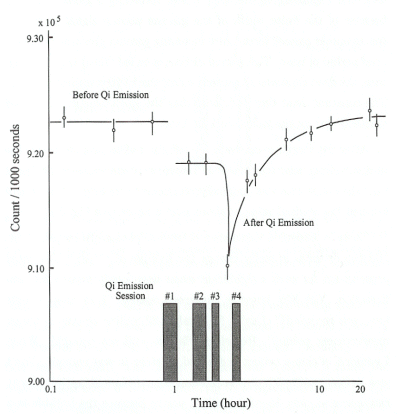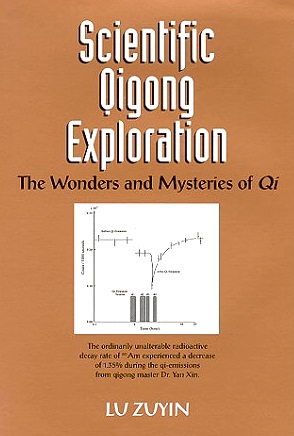Excerpted from Professor Lu Zuyin’s “Scientific Qigong Exploration”, a survey of qigong research experiments conducted in China between 1978 and 1992.
Scientific research in the last ten years has captured many external qi phenomena and qualitatively recognized certain characteristics of external qi. On the whole, research on external qi is still at a qualitative stage. It is not easy to establish quantitative laws and phenomenological theories thereby moving to a quantitative stage.
The difficulty is mainly due to insufficient investigation of external qi and the resulting lack of scientific means to express the level of external qi. With more than a thousand qigong schools and numerous different qigong methods, it is difficult to establish common standards.
In addition, a qigong master’s qi-emission power is closely related to his own physical, mental, emotional state at the time of qi emission. As a result, each external qi emission is at best only roughly the same, and it is not as precisely reproducible as an instrument. Experiments seeking basic laws of external qi are not easy to accomplish because they require tens or even hundreds of strictly repeated experiments.
[As demonstrated by our previous experimental results,] qigong is more advanced than contemporary science, thus it is difficult to fit into the framework of contemporary science. However, like all fields of scholarship, if qigong research does not pass strict scientific examination, it will not survive in contemporary society, let alone be accepted in international academic circles. This is a fundamental contradiction.
This contradiction is first revealed in methodology. Modern science subscribes to the notion that an experimenter should remain completely independent of the test object, thereby assuring results unaffected by the experimenter’s thoughts; otherwise, the results are considered unreliable. In other words, the subject and the object must be separate and independent. However, traditional qigong pays close attention to consciousness and to the effect of the consciousness of an object–the observer and the observed are connected.
The conflict of these two methodologies stems from two different epistemologies: the dualism of separated spirituality and materiality, and the monism of a combined spirituality and materiality (qi theory).

Effects of Yan Xin’s external qi on
gamma ray count from 241Am decay.
(Published in Ziran Zazhi, Vol. 11, 1988)
Sample size and reliability
One major criticism of our external qi experiments was that the number of samples used in the experiments was too small to draw significant conclusions. It is true that in medical and most biological experiments, a large number of samples are required to make clear conclusions. In physics, chemistry, and certain molecular biology experiments, however, small sample sizes do not necessarily produce unreliable results.
The study of a new phenomenon involves two different stages: discovery of the phenomenon, and exploration of the laws governing the phenomenon. The analysis in the first stage is a question of the statistical significance of the experimental result, to judge whether the observation represents a new phenomenon, or just a false signal caused by background statistical fluctuation.
For a significance test, it is important to have a precise understanding of the background noise. A large sample size is required for background measurement but not for the new phenomenon; a few events [of sufficient magnitude] are enough to indicate its existence.
Can qi influence atomic nuclei?
One pleasantly cool evening in September 1987, Dr. Yan Xin came to my home. My wife (Zhu Runsheng) and I chatted while sitting around a table and drinking tea. Yan Xin said, “Can we do some further experiments to explore deeper levels of matter? I want to conduct some more difficult and extraordinary experiments.” We went into deep thought for awhile, and suddenly Zhu Runsheng said, “Can you affect the decay of an atomic nucleus?”
“Each radioactive element has its own specific half-life—the time needed for its radioactive strength to be reduced by half. For example, the half-life of 60Co used for radioactive therapy in hospitals is 5.2 years.”
“Half-life is an intrinsic property of various radioactive nuclei. It will not be affected by any ordinary physical or chemical environments. High temperature, high pressure, electrical fields, magnetic fields, acid or alkali, none of them can change the half-life. This is a basic fact of nuclear physics. Can external qi change it?”
Yan Xin was obviously attracted by this suggestion. His eyes shone and his mind was fully focused. He thought for a moment and then said excitedly, “No problem. Let’s try it.”

The following day, we found Associate Professor Zhang Tianbao at the Positron Physics Laboratory of the Institute of High Energy Physics. He had a high performance gamma ray spectrometer and a quality high-purity germanium detector. We selected a relatively stable radioactive source 241Am, with a half-life of 458 years…
The results of this experiment and many others, originally published in Chinese, are detailed in the book.
I shall add this to my traveling reading list. With luck interlibrary loan will get it to me before I’m gone.
One to add to my reading list for sure.
My teacher of Yang Public form mentioned something he saw, where a qigong master was put on the street and told to affect people, who were not told he was a master. The result! Nothing.
Then the same experiment took people who had ZERO qigong training and then had then wave their arms around and then people were told that the person was a qigong master, and lo and behold they were affected and could feel the chi.
I have observed will interfere with electrical appliances many times. The sphere of the influence of consciousness does not appear to end at the skin but acts like a field, at least in my experience.
The experiments in the book were designed to address the common objection, that qigong treatment is simply a form of psychological suggestion, and nothing more. Thus the targets were not people, but water, E. coli bacteria, liquid crystal, bromine solution, RNA and DNA, synthesis gas, and americium isotope 241.
Didn’t want to give away the ending? Did you get paid to write this entry??
Interesting reading, I’ll be looking into it as well.
No I did not get paid to write this entry!!!